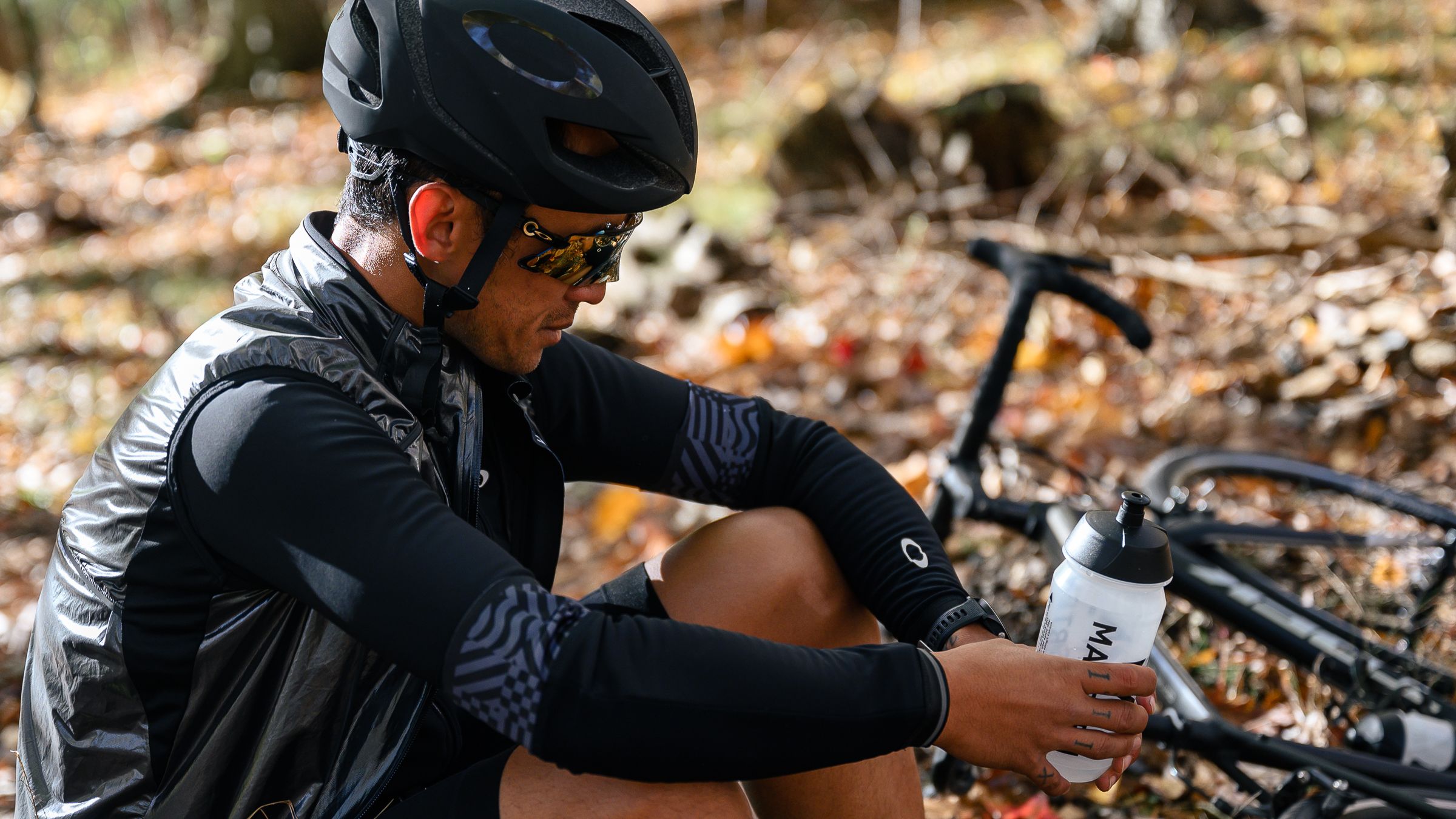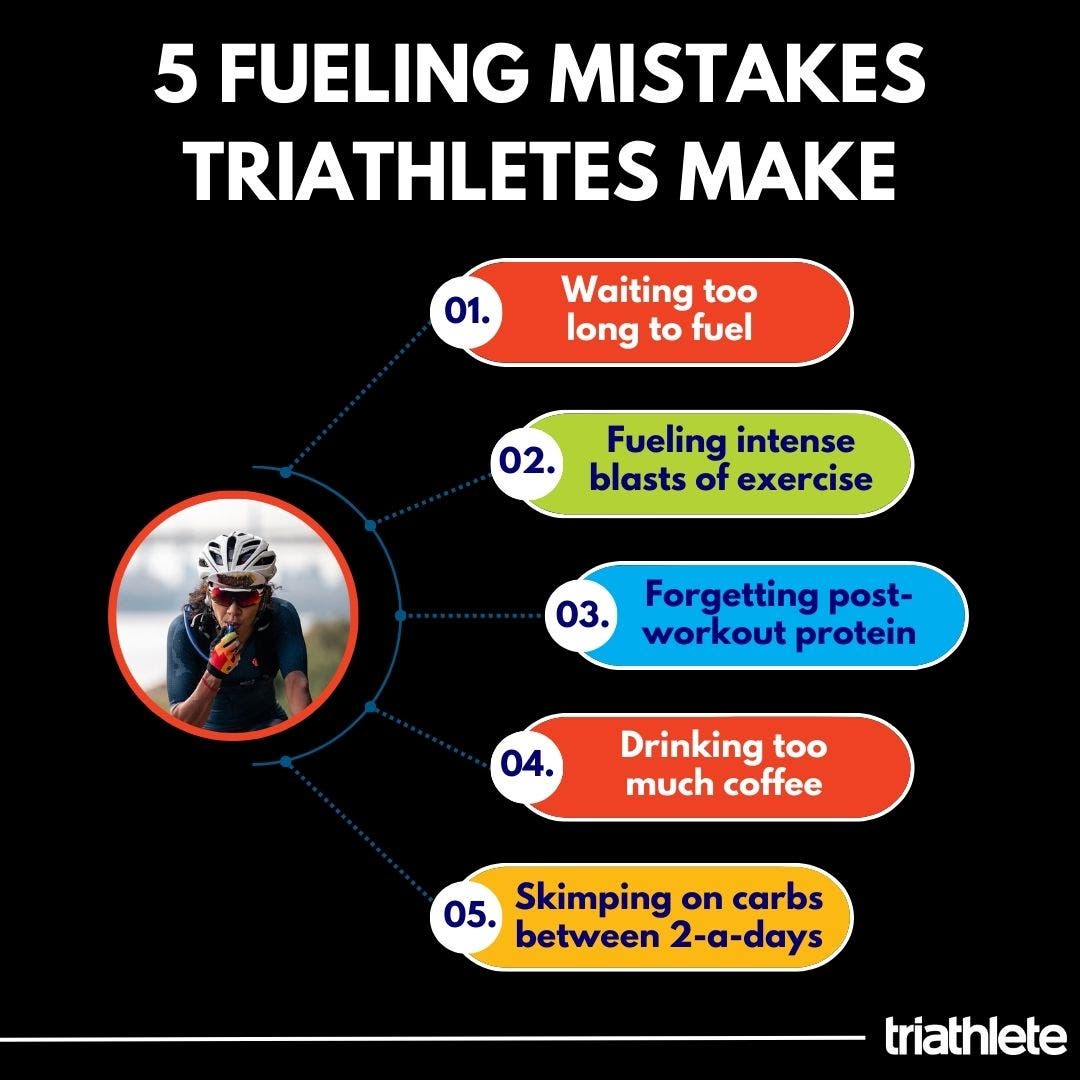These 5 Fueling Mistakes Could be Derailing Your Workouts and Races

Fixing fueling mistakes can improve your swim, bike, and run performance. (Photo: Johnny Zhang)
Fueling Mistakes Triathletes Make
Whether you’re a pro triathlete or a weekend warrior just looking to improve, how you fuel for triathlon is a vital part of the performance equation. By “fuel,” of course, we mean the nutrition you provide your body before, during, and soon after working out. Just like gas for a jet engine, proper nourishment gives your body the energy it needs to crank out the miles. To crush any fitness goal, it’s important not to make some common fueling mistakes — nutrition fumbles that could easily knock you off the podium or struggling through the final miles instead of earning that PR.
Luckily, most sports nutrition missteps are easy enough to remedy once you’ve recognized they have snuck into your training routine. To keep ahead of the pack, here’s how not to fall prey to the nutrition practices that aren’t fueling athletic success.

Fueling mistake: You wait too long to fuel
You feel good starting off but as the workout goes on, your energy starts to dissipate exponentially until suddenly you are amid an #epicbonk. It could be that you are (like too many athletes) guilty of waiting too long to fuel the engine (hello, cyclists gunning for that mid-ride pastry hit). If you want to keep racing along at a speedy clip, it’s better to give your working body calories early and often.
In a randomized, cross-over design study in the International Journal of Sports Nutrition and Exercise Metabolism British researchers found that when subjects consumed smaller amounts of carbohydrate in the form of sucrose at frequent intervals (15 times every 5 minutes) during a treadmill running test they were able to run longer until exhaustion set in than when they performed a running trial where the same amount of carbohydrate was provided but in this case all at once after 75 minutes of exercise. The early and frequent approach to fueling resulted in less muscle glycogen use which spared this precious energy source during the initial phases of activity leading to performance gains.
In a separate investigation published in the Journal of Strength and Conditioning Research, cyclists who consumed a gel every half hour during a two-hour steady-state ride were able to push harder during a subsequent 15-minute time trial than those who ate the fast-digesting carb every 45 minutes. Frequent fueling can also be a recipe for fewer stomach woes if you take in fewer calories more often rather than consuming greater amounts in one or two shots.
How to do it right:
If you are going out for the long haul, make it a priority to consume fuel (gels, chews, etc.) frequently from the get-go and most certainly before the onset of hunger, a very good indicator that you have waited too long and are at risk of smashing into the wall.
Fueling mistake: You’re fueling intense blasts of exercise
If you’re training protocol involves some sessions of intense interval training, don’t feel that you need to stuff your jersey pocket with berry blast energy gels. In this case, it might be adequate to go with water alone. Researchers from the Sport & Exercise Sciences Research Institute in the United Kingdom discovered that when male and female athletes participated in two separate workouts that involved four 30-second bouts of maximal sprint efforts (with 3 1/2 minutes of slow pace recovery between each interval) they did not experience any benefit in power output during the intervals if an 8-percent carbohydrate solution was consumed immediately before the exercise trail and then again before the second interval compared to when a carb-free placebo was consumed. Physiological responses including blood lactate, heart rate, and ratings of perceived exhaustion were unaltered by carb ingestion.
It appears that prolonged steady-state exercise necessitates a greater need for exogenous fuel where muscle glycogen stores are stressed than does much shorter but higher-intensity interval training sessions. And sucking back gels during these forms of exercise where digestion rates are even slower could bring on GI pushback.
How to do it right:
While it’s always a smart move to take in fuel during prolonged bouts of exercise if you’re heading out for just a handful of hill repeats it’s probably fine to rely on your existing energy stores. There is also the chance that participating in interval training involving maximum efforts without ingesting calories could bring about positive metabolic adaptations, a concept that needs more research.
Fueling mistake: You’re forgetting about protein post-workout
Post-workout protein isn’t only a priority for bodybuilders. Endurance-focused athletes also need to consume enough of this macronutrient after working up a sweat to help kickstart muscle recovery and to allow for necessary training adaptations. A recent report in the American Journal of Clinical Nutrition determined that consuming 30 grams of protein shortly after a bout of endurance exercise (one where bench presses and squats were not involved) helps maximize muscle protein synthesis.
Following a spirited workout, your muscle cells are primed to respond to a fresh supply of the amino acids that make up protein to help builder bigger, stronger muscles—a key part of increasing exercise power output and also injury prevention. This protein also helps make up for any muscle protein that you may have burned up during a long effort. The essential branched-chain amino acids—leucine, isoleucine, and valine—that are found in so-called “complete” proteins are particularly important for turning on the muscle-making machine after a bout of prolonged endurance exercise.
How to do it right:
Within an hour or two of pounding the pavement or riding into the mountains be sure to reach for some high-protein foods. Powders containing isolated proteins, such as whey, can certainly help you reach your post-training protein needs, but so too can whole food options of complete protein like cottage cheese, chicken, eggs, tempeh, and quinoa. We have a whole primer on protein powders for triathletes here – study up, then drink up.
Fueling mistake: You’re drinking too much coffee
It’s safe to say that caffeine is the most widely used stimulant in the athletic world, but to counteract the caffeine tolerance that can come with a daily espresso habit, research suggests you may need to swear off the brew temporarily (cue the collective sigh).
Researchers from the Camilo José Cela University in Spain provided healthy active adults who were typically light caffeine users, defined as consuming fewer than 50 milligrams per day, much less than the 100 to 350 milligrams in a cup of coffee, with a daily pill containing 3 milligrams of caffeine per kilogram of body weight for 20 days. For a separate 20-day period the subjects took a caffeine-free placebo. Before and after each study period, and three times a week during the 20 days, the volunteers completed a VO2max test to exhaustion and a 15-second all-out sprint on an exercise bike. The results published in the journal PLOS One found that as soon as the people started taking caffeine, on day 1, they benefited from a roughly 5 percent boost in peak power compared to the placebo. But then after the first few days, things started to taper off to the point that by day 11 the peak power performance difference between the caffeine and no-caffeine became closer to even. VO2max performance on day 20 in the caffeine trial looked pretty similar to that of day 6.
This suggests that when your body is not used to being stimulated by caffeine and then gets a shot of the stuff you’re in a state of heightened caffeine sensitivity that can noticeably boost your workouts. But with regular use, there can be a habituation effect that dulls caffeine’s ergogenic benefits. Though caffeine tolerance appears not to completely wipe out the performance benefit, it does seem to rob you of a little bit of an extra edge which can make or break your run for the podium.
A separate investigation in the International Journal of Sports Nutrition found that male athletes who typically consumed low amounts of caffeine daily experienced less of a drop in performance during repeated sprint performances after consuming a caffeinated chewing gum containing 200 milligrams of the stimulant compared to people who were moderate-to-high caffeine consumers. The upshot is that a pre-race caffeine detox might be a worthwhile strategy if you’re looking to shave off seconds.
How to do it right:
If you’re gearing up for an important race or workout and hoping to get the biggest performance-boosting jolt possible from caffeine (either from coffee or a supplement), it can be a good idea to go without your second or third daily cup of Joe in the days leading up to the event. You probably don’t need to cut out caffeine completely – but cutting back might confer some benefits. You can try 5 days of little to light caffeine consumption, before ramping up the intake on game day.
But this advice comes with a couple of caveats. For some people, the side effects of going off caffeine – such as migraines leading up to a race – are dire enough to negate any performance benefit. And there’s also some interesting research suggesting that the genetic makeup of some people means they don’t benefit athletically from caffeine no matter if they have tolerance or not. We go deeper into the notion of a “caffeine taper” in this article: Should You Cut Out Caffeine Before a Race?
Fueling mistake: You skimp on carbs between two-a-day workouts
Many triathletes aren’t opposed to split workouts, say a swim in the morning and run or ride later in the day. But if you don’t focus on eating enough carbohydrates in the hours between these workouts, a scenario that can easily occur when a busy day gets in the way of eating, your second sweat session of the day could be lackluster.
This fueling mistake was played out in a Medicine and Science in Sports and Exercise study which found that endurance-trained individuals who consumed a low-carb test drink (0.3 grams of carb per kilogram body mass) every 30 minutes during a 4-hour recovery period after a run to exhaustion at 70 percent of VO2max performed significantly worse during a second run compared to when they were provided with a high carbohydrate solution (1.2 grams of carbs per kilogram body weight) following the initial bout of exercise. Participants were able to run 60 percent longer during the second run when they took in more carbs throughout the recovery period. Muscle glycogen concentrations were higher at the end of the recovery period when participants received the high-carb drink and, therefore, they could rely more heavily on this energy source to improve exercise capacity.
How to do it right:
If you’re training involves some two-a-day workout sessions be sure to consume plenty of carb-rich foods between bouts to replenish glycogen levels. This is especially true if your first workout was prolonged and/or vigorous which will drain more of your muscle glycogen stores. Your carbs can hail from a combination of sports drinks, fruits, grains, and potatoes.
And instead of inhaling all your carbs in one go, a better refueling strategy is to spread your intake throughout the recovery timeframe. So if you have a 5-hour window between sweat sessions you could aim to take in between 50 and 75 grams of carbohydrate each hour between the two workouts. The exact amount of carbs and frequency requires a bit of trial-and-error based on factors like individual digestion rates, body weight, and intensity of workouts. For more on this, check out Why Carbs Are So Important for Recovery.